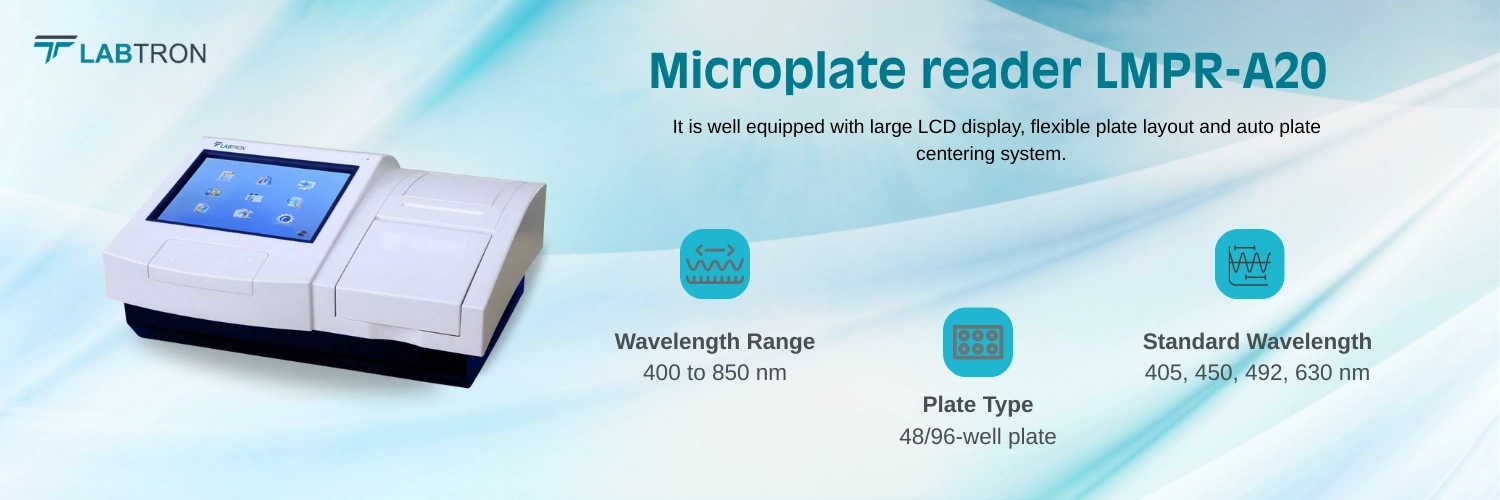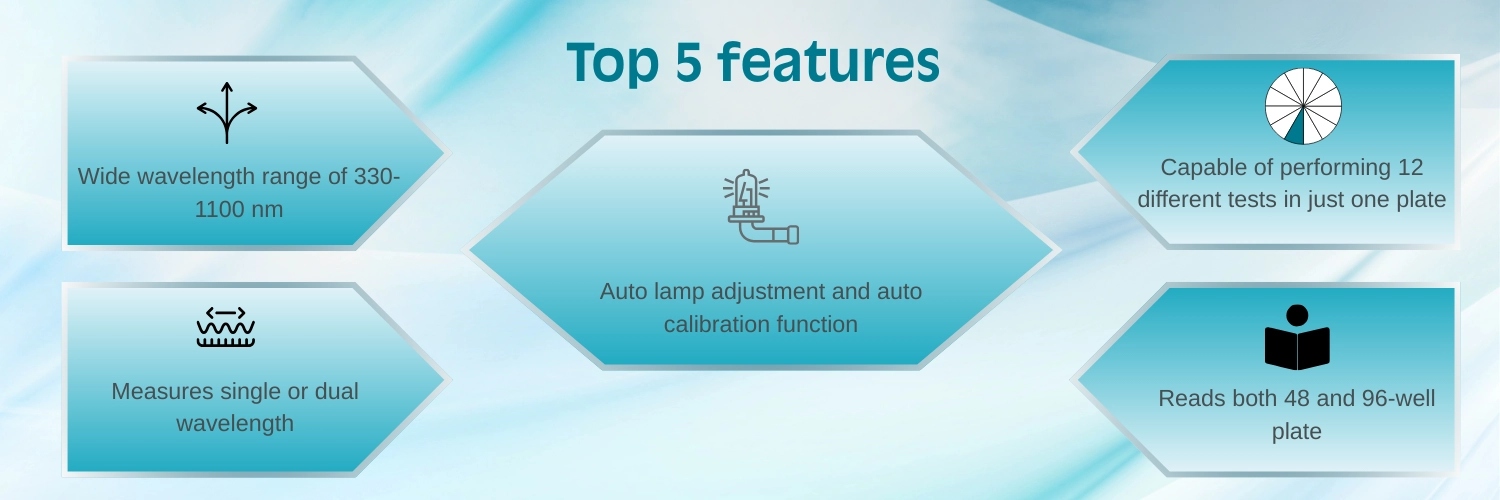


Microplate Reader LMPR-A20 offers a broad wavelength range of 400 to 850 nm and a filter wheel for expanded application flexibility. It provides an absorbance range from 0.000 to 4.000 Abs, with excellent accuracy, reproducibility, and stability. Its linear shaking function offers three speed options for optimal mixing. Its multiple interface connections, allow seamless integration into laboratory workflows. In addition, this reader is an ideal choice for various research and diagnostic applications.
| Plate Type | 48/96-well plate |
| Wavelength Range | 400 to 850 nm |
| Standard Wavelength | 405, 450, 492, 630 nm |
| Additional filters | Filter wheel for up to 8 filters |
| Resolution | 0.001 Abs |
| Reading Speed | Single wavelength ≤ 3s; dual wavelength ≤ 6s |
| Reading Range | 0.000-4.000 Abs |
| Accuracy | ± 0.008 Abs |
| reproducibility | ≤ 0.2 % |
| stability | ± 0.003 Abs |
| Shaking | Linear shaking, 3 speeds |
| Printer | Built-in thermal printer, optional external printer |
| Light Source | 8V/50W controlled tungsten halogen lamp |
| Detector | Silicon photodiode |
| Interface connection | DVI, UGA,NETWORK INTERFACE, USB, AUDIO INTERFACE, RS-232 |
| Overall Dimension | 460x350x197 mm |
| Power Supply | 100-240 V, 50-60 Hz |
| Weight (Net/Gross) | 10 kg |
Our Microplate Reader LMPR-A20 is ideal for a wide range of applications in clinical diagnostics, biomedical research, pharmaceuticals, environmental monitoring, and food safety testing.
Download catalog for
Microplate Reader LMPR-A20 Catalog


Labtron Microplate Readers have multiple wells (commonly 48, 96, 384, or 1536) that serve as small test tubes. These are used to detect biological, chemical, or physical events in samples within microtiter plates. Our advanced models offer a range of wavelengths, allowing users to customize the absorbance or fluorescence measurements according to specific requirements. With their high sensitivity and dynamic range, they are capable of detecting very low and high signals. They come with specialized software for controlling the reader, setting up protocols, and analyzing the collected data. To ensure that reagents and samples are well-mixed before measurement, our microplate readers include shaking or stirring functions.








The Microplate Reader LMPR-A20 supports a comprehensive range of optical filters covering wavelengths between 400 nm and 800 nm. This flexibility allows users to select filters that best suit their specific assay requirements, enabling accurate measurements for a wide variety of applications, including ELISA, protein assays, and other absorbance-based analyses.
The Microplate Reader LMPR-A20 is equipped with four standard filters—405 nm, 450 nm, 492 nm, and 630 nm, commonly used in most routine laboratory assays. In addition to these standard filters, a wide selection of optional filters is available. Any filter within the wavelength range of 400 nm to 800 nm, apart from the four standard ones, can be selected as an optional accessory, allowing users to customize the instrument to meet their specific experimental needs.
Our product is designed to accept 48 or 96 well plates.
48 to 96 well plates can accommodate more sample volume and detect with great sensitivity in very less amount of time, thereby results in quick and easy analysis, as compared to other high numbered well plates such as 1536 to 3456 readers.
A Microplate Reader, commonly called as plate reader or plate spectrophotometer, is an analytical instrument that reads or detects the physical, chemical, and biological events of the analyte, within the wells of the plate. It has numerous tiny wells where the sample analyte is introduced for analysis.
A standard spectrophotometer measures the absorbance of one sample at a time. The sample is typically placed in a cuvette through which light is sent horizontally. An absorbance plate reader offers higher throughput and can measure the absorbance of samples in microplates (typically 96-well or even 384-well) by sending light through each well vertically.
Microplate-based measurements detect light signals produced by a sample, converted by a sample, or transmitted through a sample. In the plate reader, the signal is measured by a detector, usually a photomultiplier tube (PMT). PMTs convert photons into electricity that is then quantified by the microplate reader. The output of this process is numbers by which a sample is quantified.
Tungsten-halogen or xenon flash lamps are generally used. LEDs have also come into the picture in some modern readers.
The detection technology can be of 3 types- Monochromator based detection which provides flexibility, convenience, and spectral scanning; Filter based detection which enables rapid switch between different wavelengths; Hybrid detection which has dual technological advantage of both flexibility and sensitivity.
Post your question?
Our experts are here to help!
Labtron Equipment Ltd., Quatro House, Lyon Way, Camberley, Surrey GU16 7ER United Kingdom
Email: info@labtron.com Whatsapp: +44 73 4441 2688 Phone: +44 2080 043608